Community Development Essay: Yiriman Project Case Study Analysis
VerifiedAdded on 2022/09/30
|10
|2674
|19
Essay
AI Summary
This essay provides a comprehensive analysis of the Yiriman Project, a community development initiative originating from Aboriginal elders in West Kimberley, Australia. The essay explores the project's background, including its inception as a youth diversionary program addressing substance abuse and self-harm among young people, and its evolution into a cultural maintenance project. It details the creative processes employed, such as the planning and execution of trips that involve multiple generations in cultural activities and knowledge transfer. The essay highlights the project's strengths, including its ability to foster respect for the country, provide training opportunities, and support cultural business. It also addresses limitations, such as its divergence from modern government policies, and the challenges in measuring its impact. Finally, the essay outlines key lessons learned, emphasizing the project's success in connecting young people with their culture, family, and country, and its positive impacts on the community.
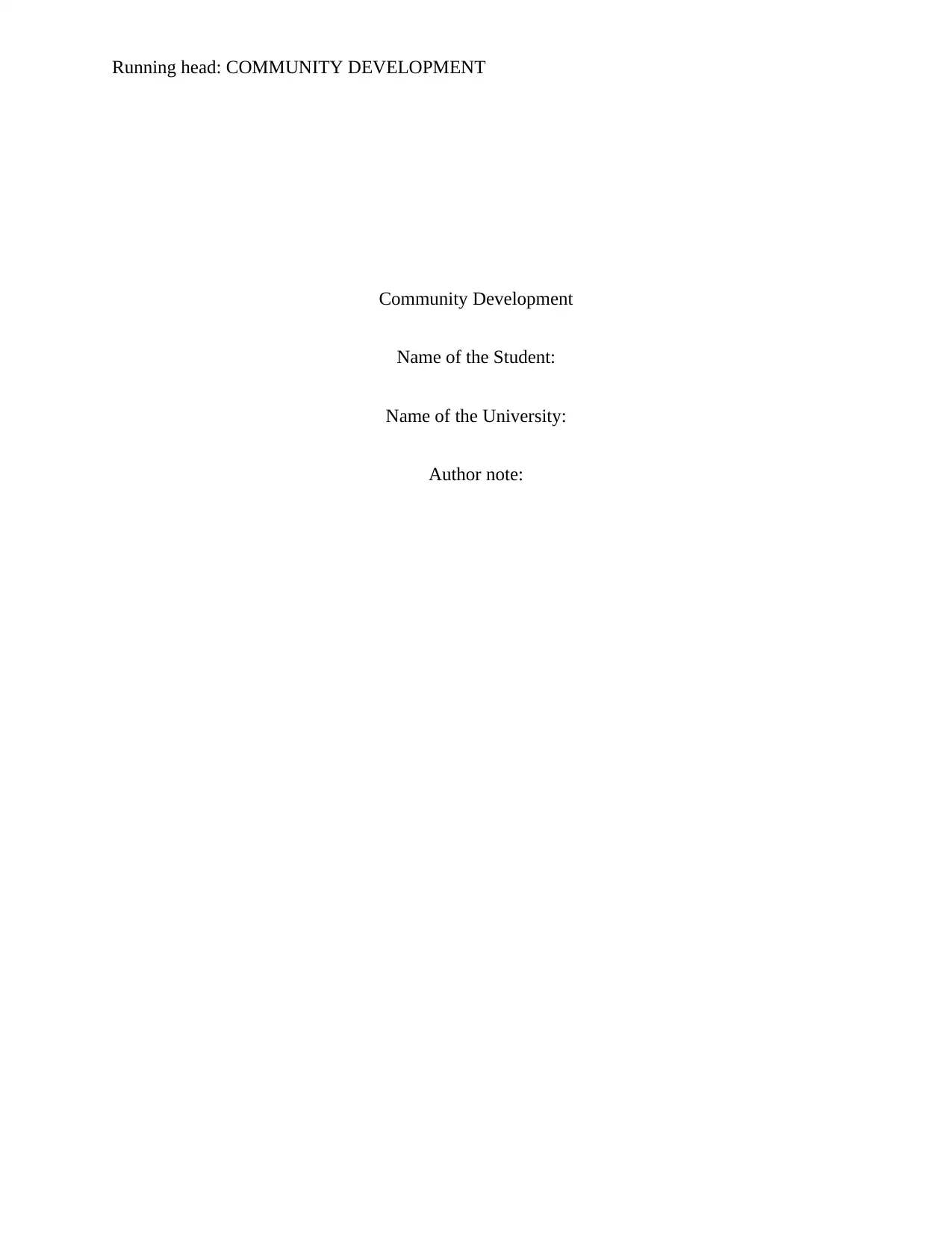
Running head: COMMUNITY DEVELOPMENT
Community Development
Name of the Student:
Name of the University:
Author note:
Community Development
Name of the Student:
Name of the University:
Author note:
Paraphrase This Document
Need a fresh take? Get an instant paraphrase of this document with our AI Paraphraser
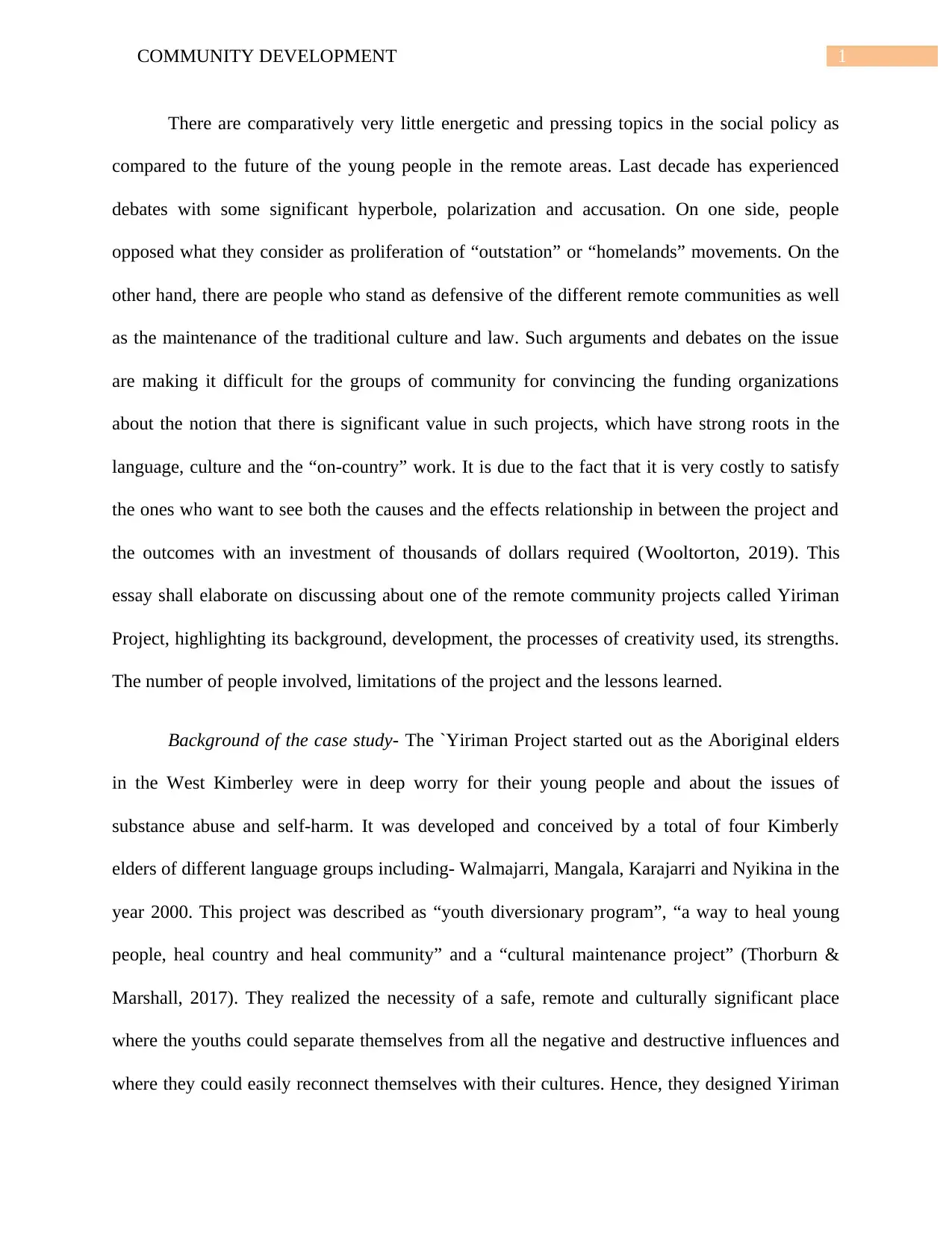
1COMMUNITY DEVELOPMENT
There are comparatively very little energetic and pressing topics in the social policy as
compared to the future of the young people in the remote areas. Last decade has experienced
debates with some significant hyperbole, polarization and accusation. On one side, people
opposed what they consider as proliferation of “outstation” or “homelands” movements. On the
other hand, there are people who stand as defensive of the different remote communities as well
as the maintenance of the traditional culture and law. Such arguments and debates on the issue
are making it difficult for the groups of community for convincing the funding organizations
about the notion that there is significant value in such projects, which have strong roots in the
language, culture and the “on-country” work. It is due to the fact that it is very costly to satisfy
the ones who want to see both the causes and the effects relationship in between the project and
the outcomes with an investment of thousands of dollars required ( Wooltorton, 2019). This
essay shall elaborate on discussing about one of the remote community projects called Yiriman
Project, highlighting its background, development, the processes of creativity used, its strengths.
The number of people involved, limitations of the project and the lessons learned.
Background of the case study- The `Yiriman Project started out as the Aboriginal elders
in the West Kimberley were in deep worry for their young people and about the issues of
substance abuse and self-harm. It was developed and conceived by a total of four Kimberly
elders of different language groups including- Walmajarri, Mangala, Karajarri and Nyikina in the
year 2000. This project was described as “youth diversionary program”, “a way to heal young
people, heal country and heal community” and a “cultural maintenance project” (Thorburn &
Marshall, 2017). They realized the necessity of a safe, remote and culturally significant place
where the youths could separate themselves from all the negative and destructive influences and
where they could easily reconnect themselves with their cultures. Hence, they designed Yiriman
There are comparatively very little energetic and pressing topics in the social policy as
compared to the future of the young people in the remote areas. Last decade has experienced
debates with some significant hyperbole, polarization and accusation. On one side, people
opposed what they consider as proliferation of “outstation” or “homelands” movements. On the
other hand, there are people who stand as defensive of the different remote communities as well
as the maintenance of the traditional culture and law. Such arguments and debates on the issue
are making it difficult for the groups of community for convincing the funding organizations
about the notion that there is significant value in such projects, which have strong roots in the
language, culture and the “on-country” work. It is due to the fact that it is very costly to satisfy
the ones who want to see both the causes and the effects relationship in between the project and
the outcomes with an investment of thousands of dollars required ( Wooltorton, 2019). This
essay shall elaborate on discussing about one of the remote community projects called Yiriman
Project, highlighting its background, development, the processes of creativity used, its strengths.
The number of people involved, limitations of the project and the lessons learned.
Background of the case study- The `Yiriman Project started out as the Aboriginal elders
in the West Kimberley were in deep worry for their young people and about the issues of
substance abuse and self-harm. It was developed and conceived by a total of four Kimberly
elders of different language groups including- Walmajarri, Mangala, Karajarri and Nyikina in the
year 2000. This project was described as “youth diversionary program”, “a way to heal young
people, heal country and heal community” and a “cultural maintenance project” (Thorburn &
Marshall, 2017). They realized the necessity of a safe, remote and culturally significant place
where the youths could separate themselves from all the negative and destructive influences and
where they could easily reconnect themselves with their cultures. Hence, they designed Yiriman
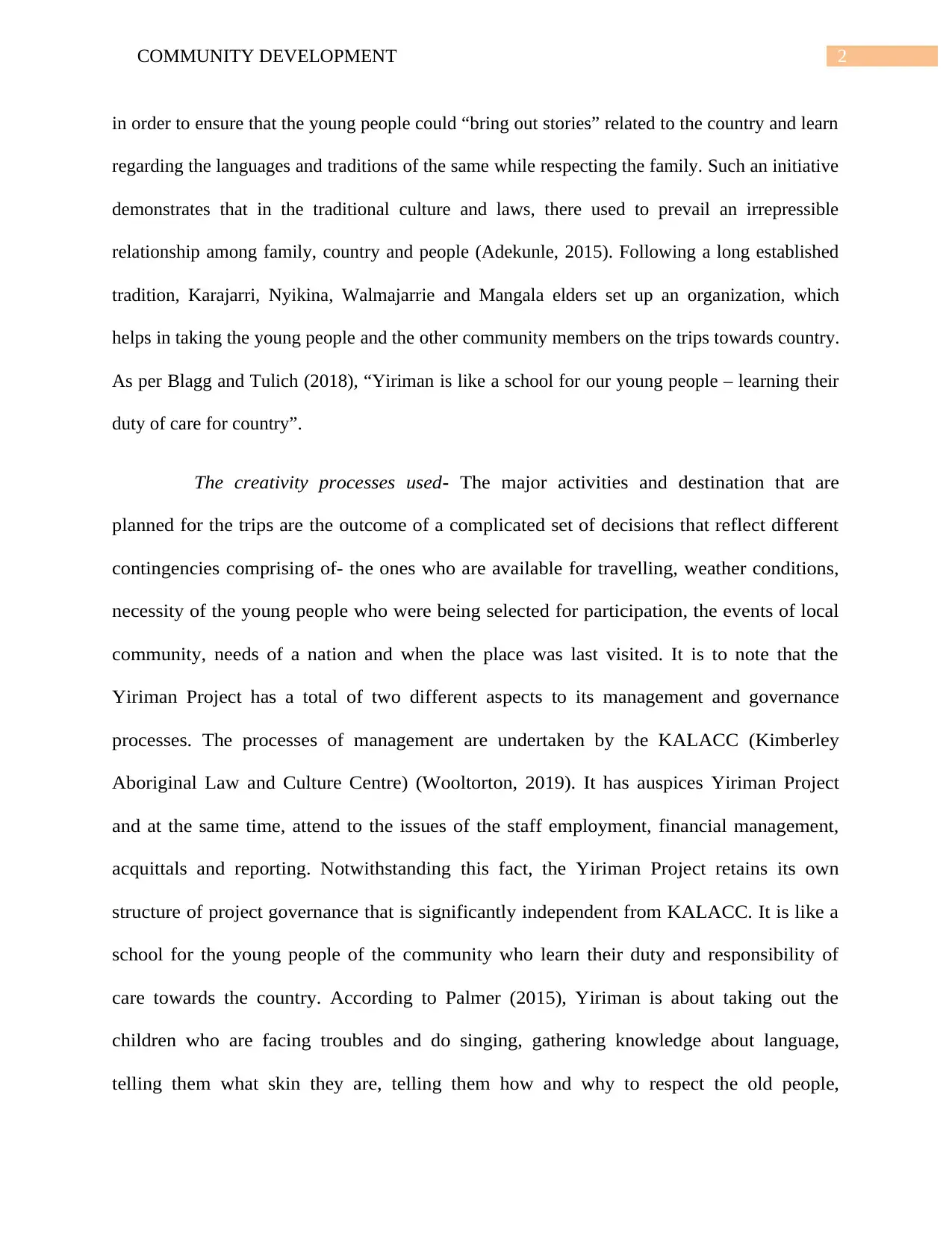
2COMMUNITY DEVELOPMENT
in order to ensure that the young people could “bring out stories” related to the country and learn
regarding the languages and traditions of the same while respecting the family. Such an initiative
demonstrates that in the traditional culture and laws, there used to prevail an irrepressible
relationship among family, country and people (Adekunle, 2015). Following a long established
tradition, Karajarri, Nyikina, Walmajarrie and Mangala elders set up an organization, which
helps in taking the young people and the other community members on the trips towards country.
As per Blagg and Tulich (2018), “Yiriman is like a school for our young people – learning their
duty of care for country”.
The creativity processes used- The major activities and destination that are
planned for the trips are the outcome of a complicated set of decisions that reflect different
contingencies comprising of- the ones who are available for travelling, weather conditions,
necessity of the young people who were being selected for participation, the events of local
community, needs of a nation and when the place was last visited. It is to note that the
Yiriman Project has a total of two different aspects to its management and governance
processes. The processes of management are undertaken by the KALACC (Kimberley
Aboriginal Law and Culture Centre) (Wooltorton, 2019). It has auspices Yiriman Project
and at the same time, attend to the issues of the staff employment, financial management,
acquittals and reporting. Notwithstanding this fact, the Yiriman Project retains its own
structure of project governance that is significantly independent from KALACC. It is like a
school for the young people of the community who learn their duty and responsibility of
care towards the country. According to Palmer (2015), Yiriman is about taking out the
children who are facing troubles and do singing, gathering knowledge about language,
telling them what skin they are, telling them how and why to respect the old people,
in order to ensure that the young people could “bring out stories” related to the country and learn
regarding the languages and traditions of the same while respecting the family. Such an initiative
demonstrates that in the traditional culture and laws, there used to prevail an irrepressible
relationship among family, country and people (Adekunle, 2015). Following a long established
tradition, Karajarri, Nyikina, Walmajarrie and Mangala elders set up an organization, which
helps in taking the young people and the other community members on the trips towards country.
As per Blagg and Tulich (2018), “Yiriman is like a school for our young people – learning their
duty of care for country”.
The creativity processes used- The major activities and destination that are
planned for the trips are the outcome of a complicated set of decisions that reflect different
contingencies comprising of- the ones who are available for travelling, weather conditions,
necessity of the young people who were being selected for participation, the events of local
community, needs of a nation and when the place was last visited. It is to note that the
Yiriman Project has a total of two different aspects to its management and governance
processes. The processes of management are undertaken by the KALACC (Kimberley
Aboriginal Law and Culture Centre) (Wooltorton, 2019). It has auspices Yiriman Project
and at the same time, attend to the issues of the staff employment, financial management,
acquittals and reporting. Notwithstanding this fact, the Yiriman Project retains its own
structure of project governance that is significantly independent from KALACC. It is like a
school for the young people of the community who learn their duty and responsibility of
care towards the country. According to Palmer (2015), Yiriman is about taking out the
children who are facing troubles and do singing, gathering knowledge about language,
telling them what skin they are, telling them how and why to respect the old people,
⊘ This is a preview!⊘
Do you want full access?
Subscribe today to unlock all pages.

Trusted by 1+ million students worldwide
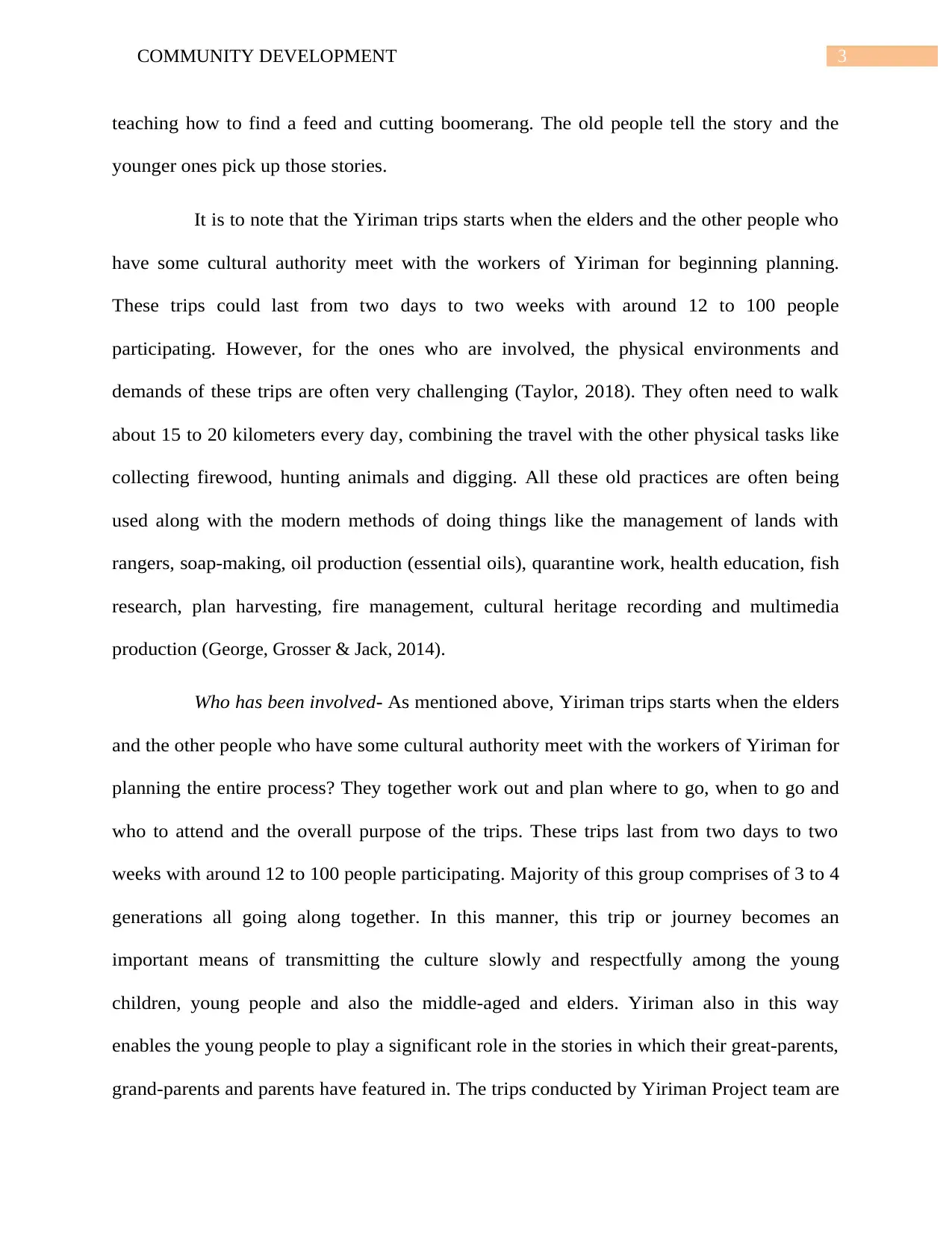
3COMMUNITY DEVELOPMENT
teaching how to find a feed and cutting boomerang. The old people tell the story and the
younger ones pick up those stories.
It is to note that the Yiriman trips starts when the elders and the other people who
have some cultural authority meet with the workers of Yiriman for beginning planning.
These trips could last from two days to two weeks with around 12 to 100 people
participating. However, for the ones who are involved, the physical environments and
demands of these trips are often very challenging (Taylor, 2018). They often need to walk
about 15 to 20 kilometers every day, combining the travel with the other physical tasks like
collecting firewood, hunting animals and digging. All these old practices are often being
used along with the modern methods of doing things like the management of lands with
rangers, soap-making, oil production (essential oils), quarantine work, health education, fish
research, plan harvesting, fire management, cultural heritage recording and multimedia
production (George, Grosser & Jack, 2014) .
Who has been involved- As mentioned above, Yiriman trips starts when the elders
and the other people who have some cultural authority meet with the workers of Yiriman for
planning the entire process? They together work out and plan where to go, when to go and
who to attend and the overall purpose of the trips. These trips last from two days to two
weeks with around 12 to 100 people participating. Majority of this group comprises of 3 to 4
generations all going along together. In this manner, this trip or journey becomes an
important means of transmitting the culture slowly and respectfully among the young
children, young people and also the middle-aged and elders. Yiriman also in this way
enables the young people to play a significant role in the stories in which their great-parents,
grand-parents and parents have featured in. The trips conducted by Yiriman Project team are
teaching how to find a feed and cutting boomerang. The old people tell the story and the
younger ones pick up those stories.
It is to note that the Yiriman trips starts when the elders and the other people who
have some cultural authority meet with the workers of Yiriman for beginning planning.
These trips could last from two days to two weeks with around 12 to 100 people
participating. However, for the ones who are involved, the physical environments and
demands of these trips are often very challenging (Taylor, 2018). They often need to walk
about 15 to 20 kilometers every day, combining the travel with the other physical tasks like
collecting firewood, hunting animals and digging. All these old practices are often being
used along with the modern methods of doing things like the management of lands with
rangers, soap-making, oil production (essential oils), quarantine work, health education, fish
research, plan harvesting, fire management, cultural heritage recording and multimedia
production (George, Grosser & Jack, 2014) .
Who has been involved- As mentioned above, Yiriman trips starts when the elders
and the other people who have some cultural authority meet with the workers of Yiriman for
planning the entire process? They together work out and plan where to go, when to go and
who to attend and the overall purpose of the trips. These trips last from two days to two
weeks with around 12 to 100 people participating. Majority of this group comprises of 3 to 4
generations all going along together. In this manner, this trip or journey becomes an
important means of transmitting the culture slowly and respectfully among the young
children, young people and also the middle-aged and elders. Yiriman also in this way
enables the young people to play a significant role in the stories in which their great-parents,
grand-parents and parents have featured in. The trips conducted by Yiriman Project team are
Paraphrase This Document
Need a fresh take? Get an instant paraphrase of this document with our AI Paraphraser
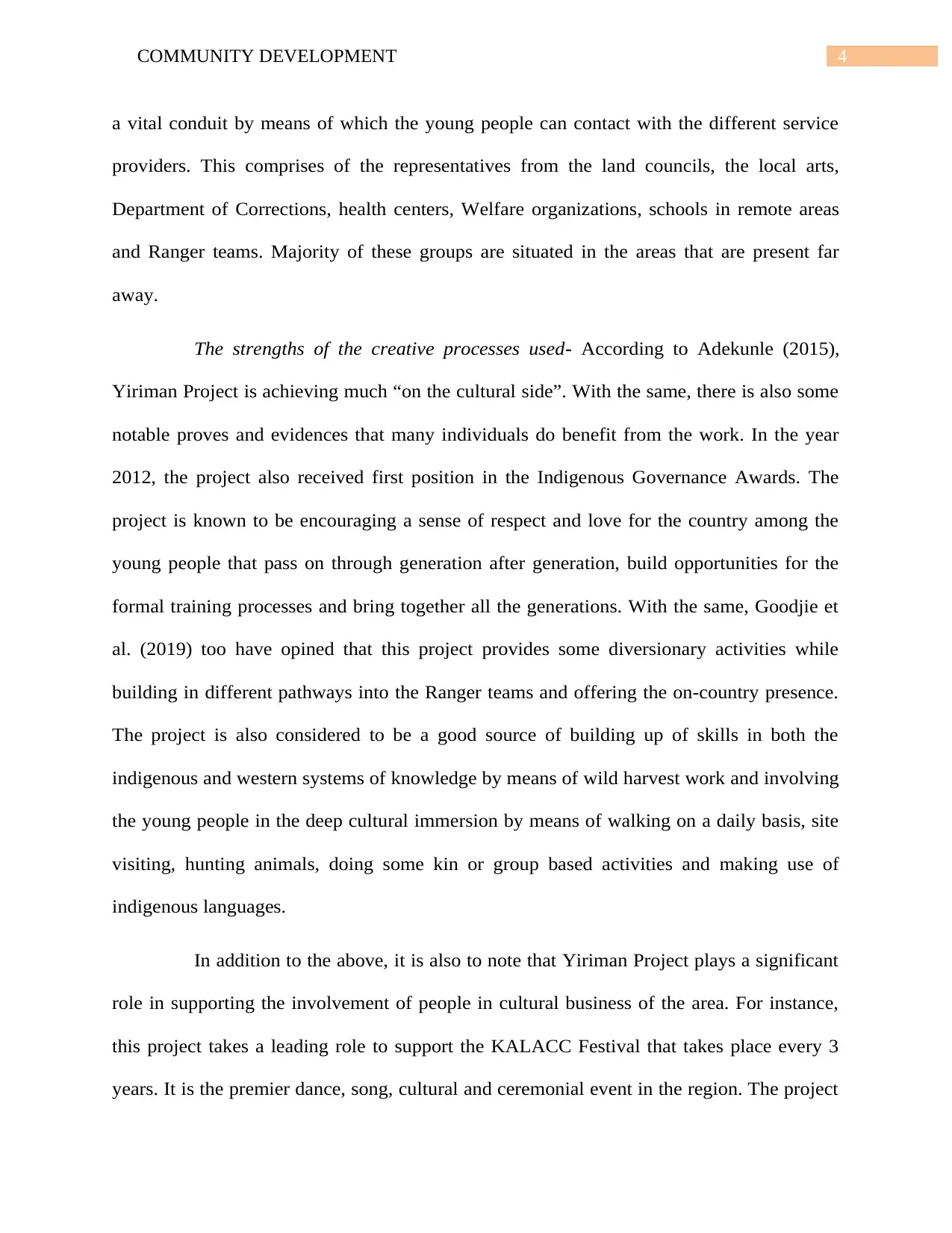
4COMMUNITY DEVELOPMENT
a vital conduit by means of which the young people can contact with the different service
providers. This comprises of the representatives from the land councils, the local arts,
Department of Corrections, health centers, Welfare organizations, schools in remote areas
and Ranger teams. Majority of these groups are situated in the areas that are present far
away.
The strengths of the creative processes used- According to Adekunle (2015),
Yiriman Project is achieving much “on the cultural side”. With the same, there is also some
notable proves and evidences that many individuals do benefit from the work. In the year
2012, the project also received first position in the Indigenous Governance Awards. The
project is known to be encouraging a sense of respect and love for the country among the
young people that pass on through generation after generation, build opportunities for the
formal training processes and bring together all the generations. With the same, Goodjie et
al. (2019) too have opined that this project provides some diversionary activities while
building in different pathways into the Ranger teams and offering the on-country presence.
The project is also considered to be a good source of building up of skills in both the
indigenous and western systems of knowledge by means of wild harvest work and involving
the young people in the deep cultural immersion by means of walking on a daily basis, site
visiting, hunting animals, doing some kin or group based activities and making use of
indigenous languages.
In addition to the above, it is also to note that Yiriman Project plays a significant
role in supporting the involvement of people in cultural business of the area. For instance,
this project takes a leading role to support the KALACC Festival that takes place every 3
years. It is the premier dance, song, cultural and ceremonial event in the region. The project
a vital conduit by means of which the young people can contact with the different service
providers. This comprises of the representatives from the land councils, the local arts,
Department of Corrections, health centers, Welfare organizations, schools in remote areas
and Ranger teams. Majority of these groups are situated in the areas that are present far
away.
The strengths of the creative processes used- According to Adekunle (2015),
Yiriman Project is achieving much “on the cultural side”. With the same, there is also some
notable proves and evidences that many individuals do benefit from the work. In the year
2012, the project also received first position in the Indigenous Governance Awards. The
project is known to be encouraging a sense of respect and love for the country among the
young people that pass on through generation after generation, build opportunities for the
formal training processes and bring together all the generations. With the same, Goodjie et
al. (2019) too have opined that this project provides some diversionary activities while
building in different pathways into the Ranger teams and offering the on-country presence.
The project is also considered to be a good source of building up of skills in both the
indigenous and western systems of knowledge by means of wild harvest work and involving
the young people in the deep cultural immersion by means of walking on a daily basis, site
visiting, hunting animals, doing some kin or group based activities and making use of
indigenous languages.
In addition to the above, it is also to note that Yiriman Project plays a significant
role in supporting the involvement of people in cultural business of the area. For instance,
this project takes a leading role to support the KALACC Festival that takes place every 3
years. It is the premier dance, song, cultural and ceremonial event in the region. The project
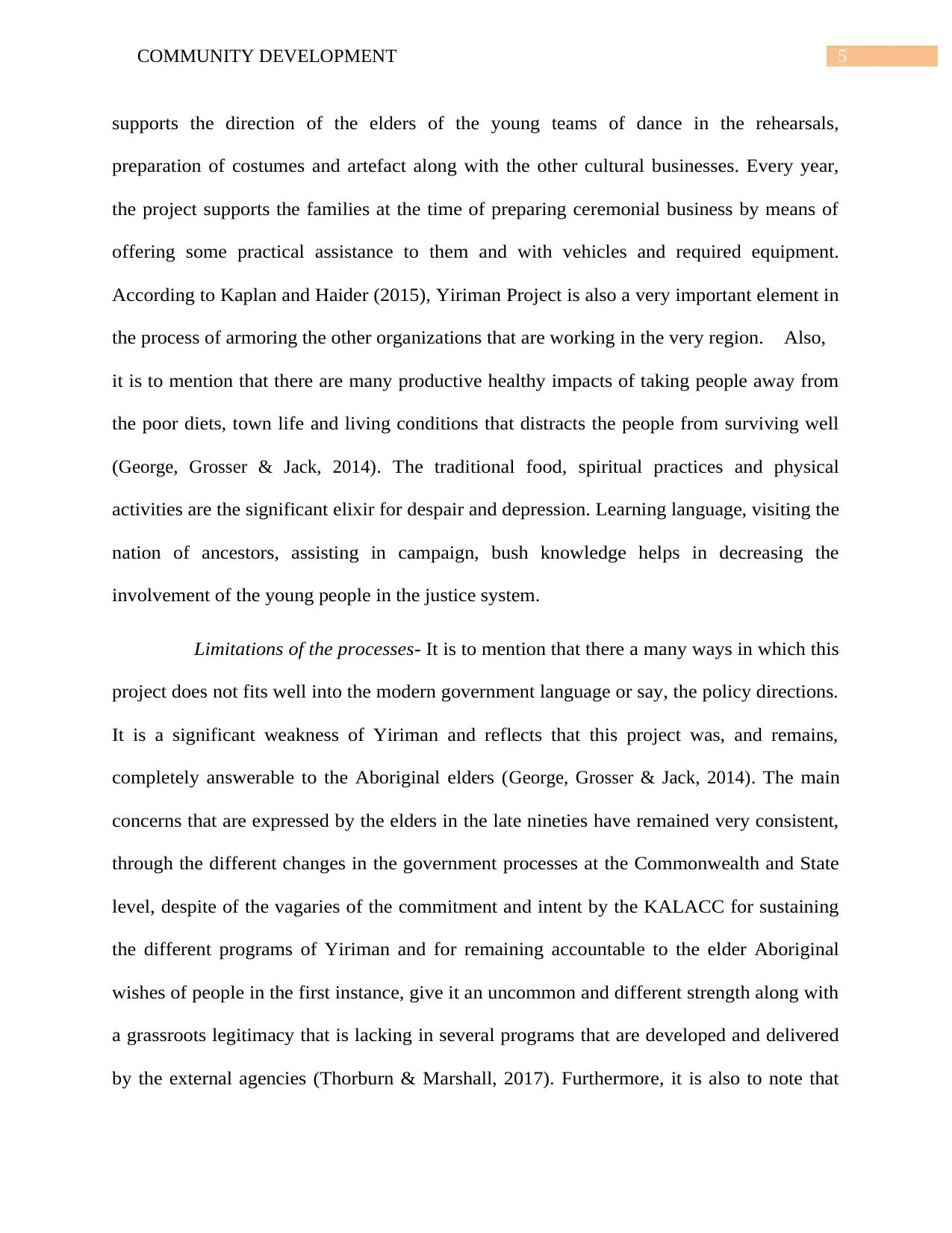
5COMMUNITY DEVELOPMENT
supports the direction of the elders of the young teams of dance in the rehearsals,
preparation of costumes and artefact along with the other cultural businesses. Every year,
the project supports the families at the time of preparing ceremonial business by means of
offering some practical assistance to them and with vehicles and required equipment.
According to Kaplan and Haider (2015), Yiriman Project is also a very important element in
the process of armoring the other organizations that are working in the very region. Also,
it is to mention that there are many productive healthy impacts of taking people away from
the poor diets, town life and living conditions that distracts the people from surviving well
(George, Grosser & Jack, 2014) . The traditional food, spiritual practices and physical
activities are the significant elixir for despair and depression. Learning language, visiting the
nation of ancestors, assisting in campaign, bush knowledge helps in decreasing the
involvement of the young people in the justice system.
Limitations of the processes- It is to mention that there a many ways in which this
project does not fits well into the modern government language or say, the policy directions.
It is a significant weakness of Yiriman and reflects that this project was, and remains,
completely answerable to the Aboriginal elders (George, Grosser & Jack, 2014) . The main
concerns that are expressed by the elders in the late nineties have remained very consistent,
through the different changes in the government processes at the Commonwealth and State
level, despite of the vagaries of the commitment and intent by the KALACC for sustaining
the different programs of Yiriman and for remaining accountable to the elder Aboriginal
wishes of people in the first instance, give it an uncommon and different strength along with
a grassroots legitimacy that is lacking in several programs that are developed and delivered
by the external agencies (Thorburn & Marshall, 2017). Furthermore, it is also to note that
supports the direction of the elders of the young teams of dance in the rehearsals,
preparation of costumes and artefact along with the other cultural businesses. Every year,
the project supports the families at the time of preparing ceremonial business by means of
offering some practical assistance to them and with vehicles and required equipment.
According to Kaplan and Haider (2015), Yiriman Project is also a very important element in
the process of armoring the other organizations that are working in the very region. Also,
it is to mention that there are many productive healthy impacts of taking people away from
the poor diets, town life and living conditions that distracts the people from surviving well
(George, Grosser & Jack, 2014) . The traditional food, spiritual practices and physical
activities are the significant elixir for despair and depression. Learning language, visiting the
nation of ancestors, assisting in campaign, bush knowledge helps in decreasing the
involvement of the young people in the justice system.
Limitations of the processes- It is to mention that there a many ways in which this
project does not fits well into the modern government language or say, the policy directions.
It is a significant weakness of Yiriman and reflects that this project was, and remains,
completely answerable to the Aboriginal elders (George, Grosser & Jack, 2014) . The main
concerns that are expressed by the elders in the late nineties have remained very consistent,
through the different changes in the government processes at the Commonwealth and State
level, despite of the vagaries of the commitment and intent by the KALACC for sustaining
the different programs of Yiriman and for remaining accountable to the elder Aboriginal
wishes of people in the first instance, give it an uncommon and different strength along with
a grassroots legitimacy that is lacking in several programs that are developed and delivered
by the external agencies (Thorburn & Marshall, 2017). Furthermore, it is also to note that
⊘ This is a preview!⊘
Do you want full access?
Subscribe today to unlock all pages.

Trusted by 1+ million students worldwide
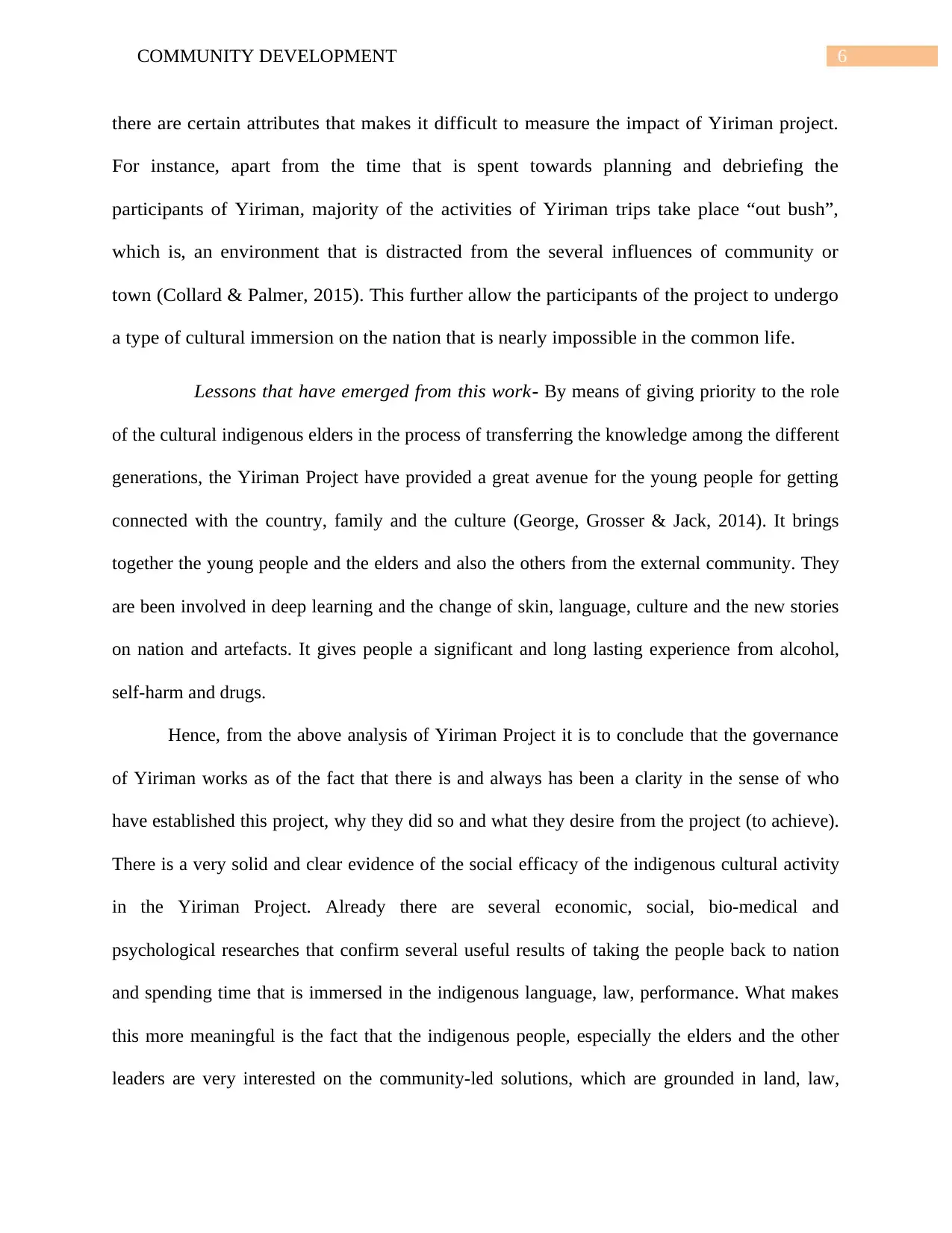
6COMMUNITY DEVELOPMENT
there are certain attributes that makes it difficult to measure the impact of Yiriman project.
For instance, apart from the time that is spent towards planning and debriefing the
participants of Yiriman, majority of the activities of Yiriman trips take place “out bush”,
which is, an environment that is distracted from the several influences of community or
town (Collard & Palmer, 2015). This further allow the participants of the project to undergo
a type of cultural immersion on the nation that is nearly impossible in the common life.
Lessons that have emerged from this work- By means of giving priority to the role
of the cultural indigenous elders in the process of transferring the knowledge among the different
generations, the Yiriman Project have provided a great avenue for the young people for getting
connected with the country, family and the culture (George, Grosser & Jack, 2014). It brings
together the young people and the elders and also the others from the external community. They
are been involved in deep learning and the change of skin, language, culture and the new stories
on nation and artefacts. It gives people a significant and long lasting experience from alcohol,
self-harm and drugs.
Hence, from the above analysis of Yiriman Project it is to conclude that the governance
of Yiriman works as of the fact that there is and always has been a clarity in the sense of who
have established this project, why they did so and what they desire from the project (to achieve).
There is a very solid and clear evidence of the social efficacy of the indigenous cultural activity
in the Yiriman Project. Already there are several economic, social, bio-medical and
psychological researches that confirm several useful results of taking the people back to nation
and spending time that is immersed in the indigenous language, law, performance. What makes
this more meaningful is the fact that the indigenous people, especially the elders and the other
leaders are very interested on the community-led solutions, which are grounded in land, law,
there are certain attributes that makes it difficult to measure the impact of Yiriman project.
For instance, apart from the time that is spent towards planning and debriefing the
participants of Yiriman, majority of the activities of Yiriman trips take place “out bush”,
which is, an environment that is distracted from the several influences of community or
town (Collard & Palmer, 2015). This further allow the participants of the project to undergo
a type of cultural immersion on the nation that is nearly impossible in the common life.
Lessons that have emerged from this work- By means of giving priority to the role
of the cultural indigenous elders in the process of transferring the knowledge among the different
generations, the Yiriman Project have provided a great avenue for the young people for getting
connected with the country, family and the culture (George, Grosser & Jack, 2014). It brings
together the young people and the elders and also the others from the external community. They
are been involved in deep learning and the change of skin, language, culture and the new stories
on nation and artefacts. It gives people a significant and long lasting experience from alcohol,
self-harm and drugs.
Hence, from the above analysis of Yiriman Project it is to conclude that the governance
of Yiriman works as of the fact that there is and always has been a clarity in the sense of who
have established this project, why they did so and what they desire from the project (to achieve).
There is a very solid and clear evidence of the social efficacy of the indigenous cultural activity
in the Yiriman Project. Already there are several economic, social, bio-medical and
psychological researches that confirm several useful results of taking the people back to nation
and spending time that is immersed in the indigenous language, law, performance. What makes
this more meaningful is the fact that the indigenous people, especially the elders and the other
leaders are very interested on the community-led solutions, which are grounded in land, law,
Paraphrase This Document
Need a fresh take? Get an instant paraphrase of this document with our AI Paraphraser
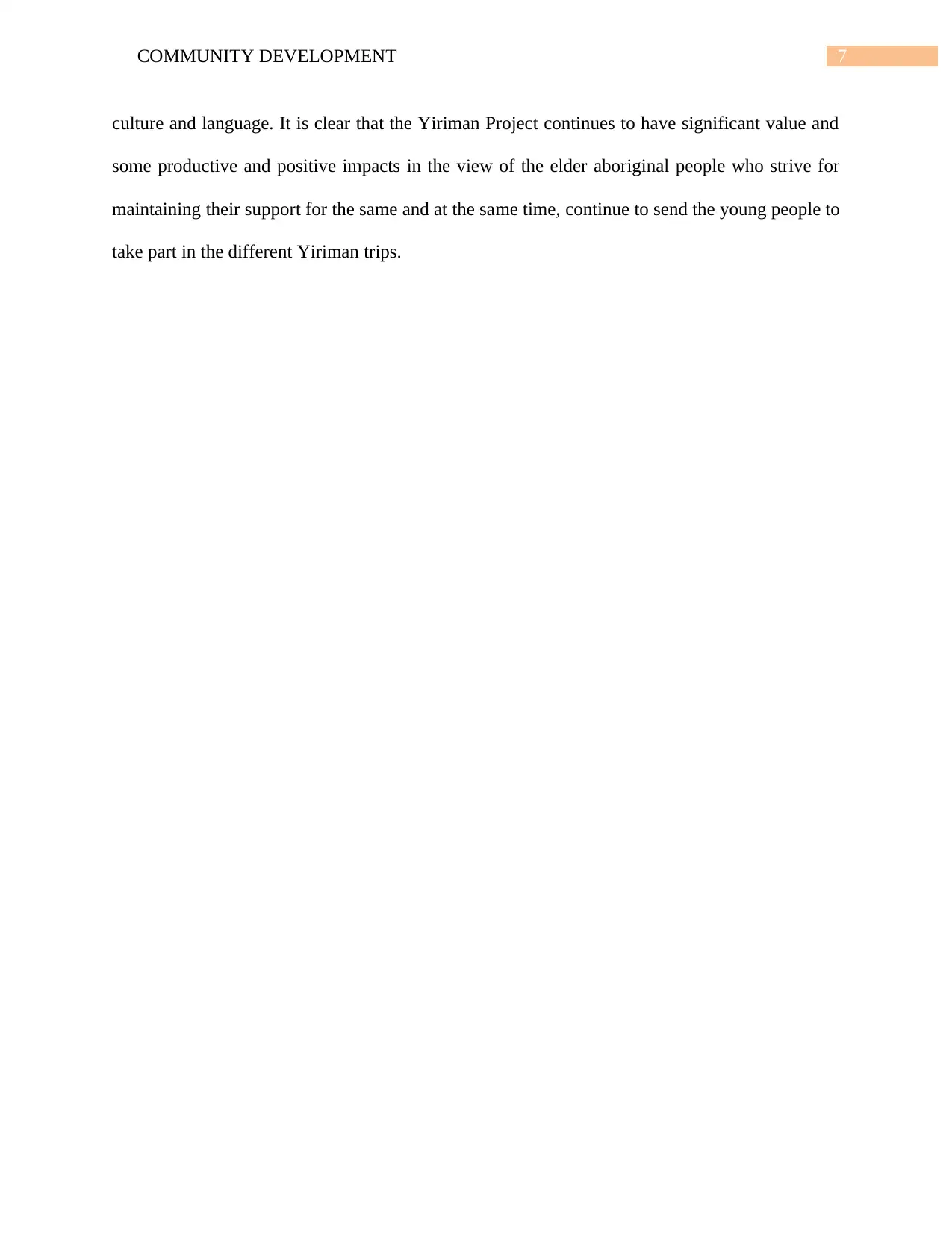
7COMMUNITY DEVELOPMENT
culture and language. It is clear that the Yiriman Project continues to have significant value and
some productive and positive impacts in the view of the elder aboriginal people who strive for
maintaining their support for the same and at the same time, continue to send the young people to
take part in the different Yiriman trips.
culture and language. It is clear that the Yiriman Project continues to have significant value and
some productive and positive impacts in the view of the elder aboriginal people who strive for
maintaining their support for the same and at the same time, continue to send the young people to
take part in the different Yiriman trips.
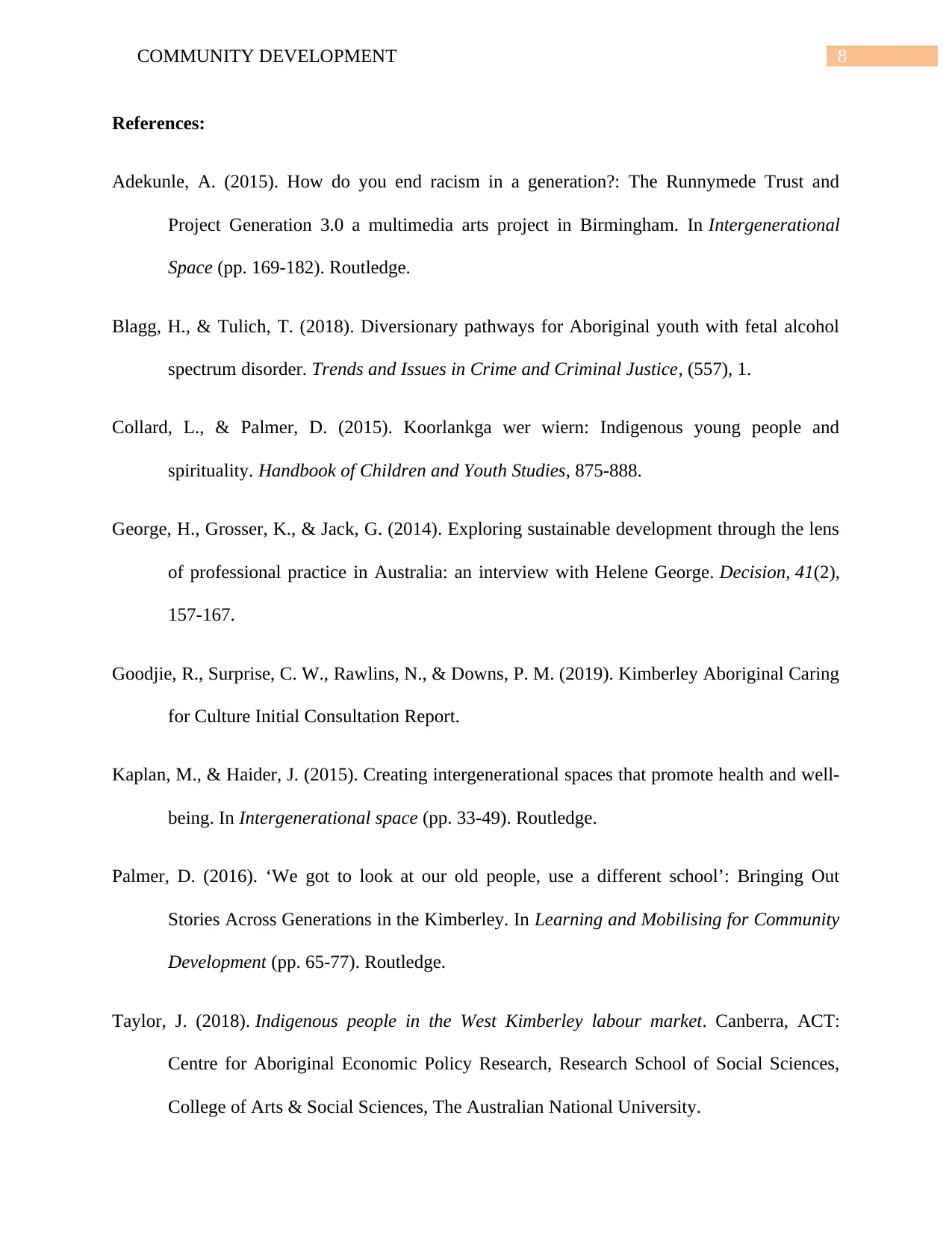
8COMMUNITY DEVELOPMENT
References:
Adekunle, A. (2015). How do you end racism in a generation?: The Runnymede Trust and
Project Generation 3.0 a multimedia arts project in Birmingham. In Intergenerational
Space (pp. 169-182). Routledge.
Blagg, H., & Tulich, T. (2018). Diversionary pathways for Aboriginal youth with fetal alcohol
spectrum disorder. Trends and Issues in Crime and Criminal Justice, (557), 1.
Collard, L., & Palmer, D. (2015). Koorlankga wer wiern: Indigenous young people and
spirituality. Handbook of Children and Youth Studies, 875-888.
George, H., Grosser, K., & Jack, G. (2014). Exploring sustainable development through the lens
of professional practice in Australia: an interview with Helene George. Decision, 41(2),
157-167.
Goodjie, R., Surprise, C. W., Rawlins, N., & Downs, P. M. (2019). Kimberley Aboriginal Caring
for Culture Initial Consultation Report.
Kaplan, M., & Haider, J. (2015). Creating intergenerational spaces that promote health and well-
being. In Intergenerational space (pp. 33-49). Routledge.
Palmer, D. (2016). ‘We got to look at our old people, use a different school’: Bringing Out
Stories Across Generations in the Kimberley. In Learning and Mobilising for Community
Development (pp. 65-77). Routledge.
Taylor, J. (2018). Indigenous people in the West Kimberley labour market. Canberra, ACT:
Centre for Aboriginal Economic Policy Research, Research School of Social Sciences,
College of Arts & Social Sciences, The Australian National University.
References:
Adekunle, A. (2015). How do you end racism in a generation?: The Runnymede Trust and
Project Generation 3.0 a multimedia arts project in Birmingham. In Intergenerational
Space (pp. 169-182). Routledge.
Blagg, H., & Tulich, T. (2018). Diversionary pathways for Aboriginal youth with fetal alcohol
spectrum disorder. Trends and Issues in Crime and Criminal Justice, (557), 1.
Collard, L., & Palmer, D. (2015). Koorlankga wer wiern: Indigenous young people and
spirituality. Handbook of Children and Youth Studies, 875-888.
George, H., Grosser, K., & Jack, G. (2014). Exploring sustainable development through the lens
of professional practice in Australia: an interview with Helene George. Decision, 41(2),
157-167.
Goodjie, R., Surprise, C. W., Rawlins, N., & Downs, P. M. (2019). Kimberley Aboriginal Caring
for Culture Initial Consultation Report.
Kaplan, M., & Haider, J. (2015). Creating intergenerational spaces that promote health and well-
being. In Intergenerational space (pp. 33-49). Routledge.
Palmer, D. (2016). ‘We got to look at our old people, use a different school’: Bringing Out
Stories Across Generations in the Kimberley. In Learning and Mobilising for Community
Development (pp. 65-77). Routledge.
Taylor, J. (2018). Indigenous people in the West Kimberley labour market. Canberra, ACT:
Centre for Aboriginal Economic Policy Research, Research School of Social Sciences,
College of Arts & Social Sciences, The Australian National University.
⊘ This is a preview!⊘
Do you want full access?
Subscribe today to unlock all pages.

Trusted by 1+ million students worldwide
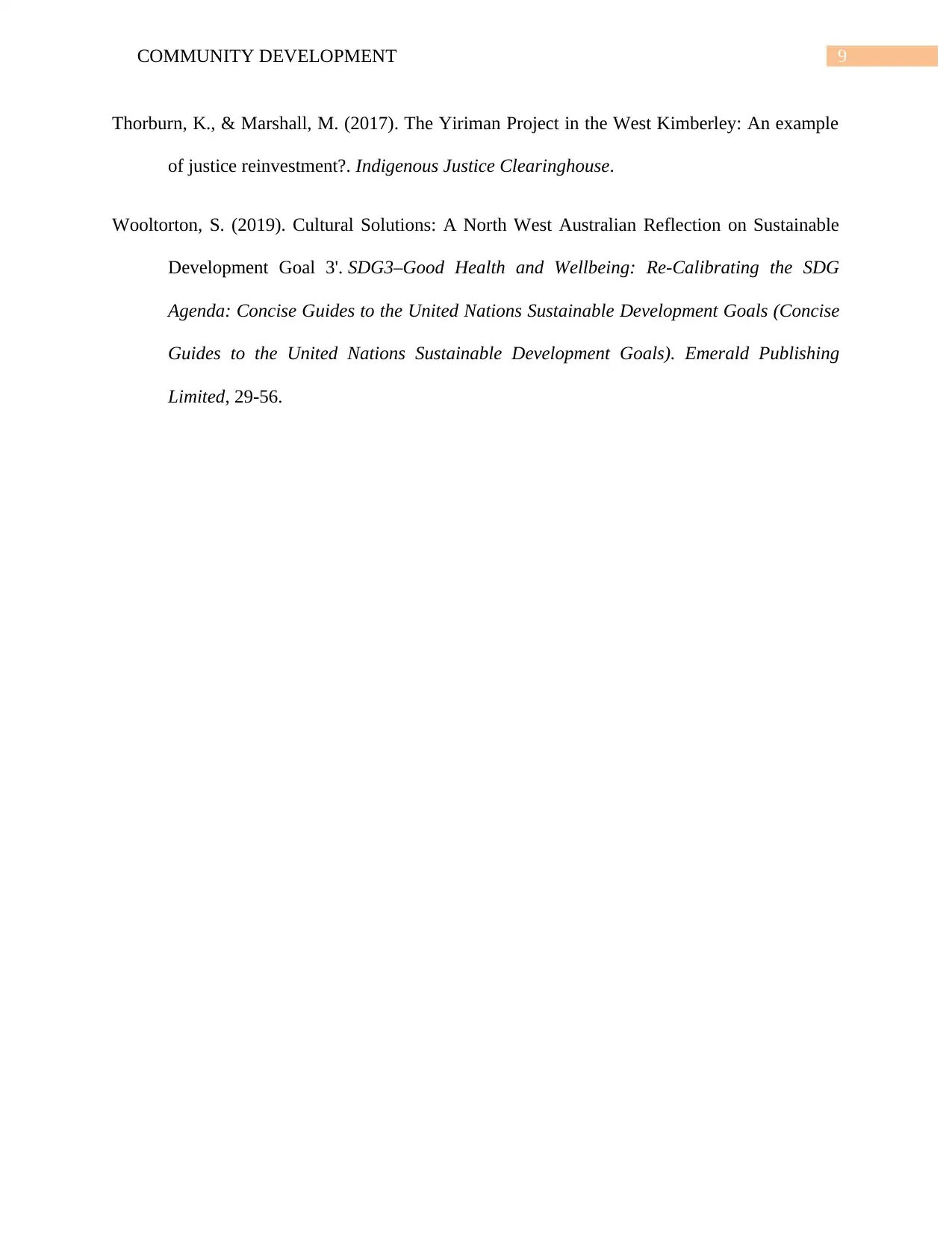
9COMMUNITY DEVELOPMENT
Thorburn, K., & Marshall, M. (2017). The Yiriman Project in the West Kimberley: An example
of justice reinvestment?. Indigenous Justice Clearinghouse.
Wooltorton, S. (2019). Cultural Solutions: A North West Australian Reflection on Sustainable
Development Goal 3'. SDG3–Good Health and Wellbeing: Re-Calibrating the SDG
Agenda: Concise Guides to the United Nations Sustainable Development Goals (Concise
Guides to the United Nations Sustainable Development Goals). Emerald Publishing
Limited, 29-56.
Thorburn, K., & Marshall, M. (2017). The Yiriman Project in the West Kimberley: An example
of justice reinvestment?. Indigenous Justice Clearinghouse.
Wooltorton, S. (2019). Cultural Solutions: A North West Australian Reflection on Sustainable
Development Goal 3'. SDG3–Good Health and Wellbeing: Re-Calibrating the SDG
Agenda: Concise Guides to the United Nations Sustainable Development Goals (Concise
Guides to the United Nations Sustainable Development Goals). Emerald Publishing
Limited, 29-56.
1 out of 10
Related Documents
Your All-in-One AI-Powered Toolkit for Academic Success.
+13062052269
info@desklib.com
Available 24*7 on WhatsApp / Email
![[object Object]](/_next/static/media/star-bottom.7253800d.svg)
Unlock your academic potential
Copyright © 2020–2025 A2Z Services. All Rights Reserved. Developed and managed by ZUCOL.





